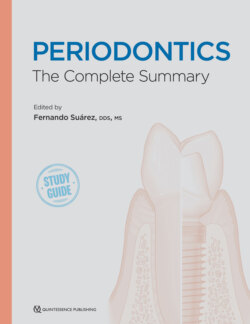Читать книгу Periodontics - Fernando Suarez - Страница 97
Root Proximity DEFINITION AND CHARACTERISTICS
ОглавлениеRoot proximity has been defined as interradicular distances (IRDs) of less than or equal to 0.8 mm or less than 1 mm presenting as a risk marker for periodontal disease.112–119 In a classic study, Heins and Wieder examined the nature of IRD spaces using human histology and reported a distance ranging from 0.2 to 4.5 mm between second premolars, first molars, and second molars.120 Interestingly, sites exceeding 0.5 mm (89.6%) of IRD showed signs of cancellous bone flanked by lamina dura. When this distance is less than 0.5 mm, a fused lamina dura was observed with no signs of cancellous bone in between. Ultimately, sites with less than 0.3 mm of IRD were connected only by the PDL (Table 5-8).120
TABLE 5-8 Histologic features based on IRD120
| Interradicular distance | Histologic features |
| ≥ 0.5 mm | Cancellous bone, lamina dura, and PDL |
| < 0.5 mm | Lamina dura and PDL |
| < 0.3 mm | Only PDL |
Vermylen et al reported a 15.3% prevalence of root proximity among 5,122 interproximal sites from 197 patients.113 It is important to note that 68% of sites were located affecting primarily maxillary molars as well as central and lateral mandibular incisors.113 In a case control study, root proximity was encountered more often at the coronal and middle thirds of the root.115 Moreover, sites with bilateral root proximity had 3.6 times greater risk of developing periodontitis. Similarly, Kim et al examined 473 patients with a mean follow-up time of 23 years to evaluate the association between root proximity and the risk for alveolar bone loss.119 The mean IRD and alveolar bone loss was 1.0 mm and 0.61 mm, respectively. Sites with less than 0.6 mm of IRD presented an increased risk for alveolar bone loss than those with 0.8 mm or more, especially in mandibular anterior teeth.
Similarly, a higher risk for occurrence of intrabony defects has been associated with IRD between 2.1 to 4.1 mm.121 Trossello and Gianelly reported more bone loss at sites with less than 1 mm of root proximity (13.4%) and in patients who had received orthodontic treatment.112 On the other hand, Årtun et al examined 400 patients who completed orthodontic treatment with at least a 16-year follow-up. Among them, 25 patients (6%) with root proximity had no significant differences regarding inflammation, attachment level, and bone level in comparison with neighboring control sites.122
